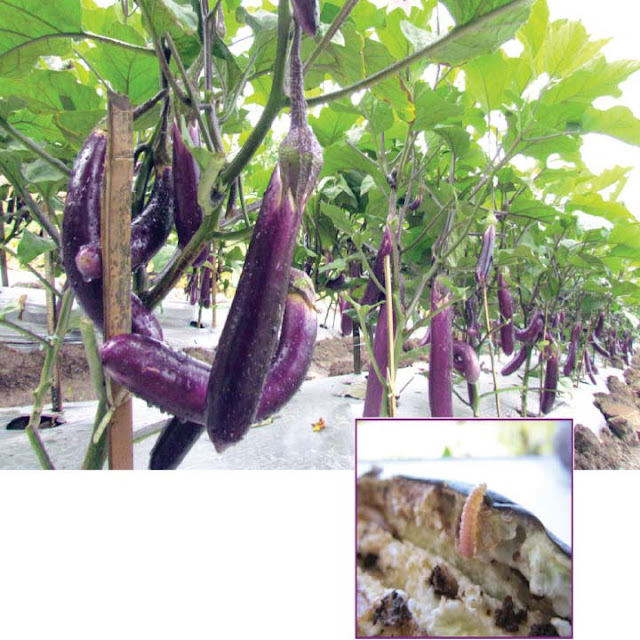Scientific name: Epilachna dodecastigma.
Family: Coccinelliadae.
Order: Coleoptera.
This is one of the major pest for vegetable crops in Bangladesh causing considerable damage to
brinjal,tomato, potato, bean and cucurbitaceous vegetables.
This is one of the major pest for vegetable crops in Bangladesh causing considerable damage to
brinjal,tomato, potato, bean and cucurbitaceous vegetables.
Nature of Damage
The beetles as well as grubs cause damage by feeding upon the epidermis of leaf tissues leaving
parallel band of uneaten tissues between the leaves. Thus present a tube like appearance. They turn
brown, dry up and fall of completely defoliating of the plant.
parallel band of uneaten tissues between the leaves. Thus present a tube like appearance. They turn
brown, dry up and fall of completely defoliating of the plant.
Life History
1. Eggs are laid in batches on the dorsal surface of the leaves.
2. Incubation period 4-6 summer and 9-10 in winter.
3. There larval stages in up to 2 weeks, pupal stages in 1 week.
4. Longevity of the beetles more than one month, the pest has 4-5 generation in a year.
Control Measure
Collection and destruction of egg masses or nully has larvae along with leaves.
Clean cultivation, crop rotation should be followed and destruction of stubbles from the field.
The infested plant/fields may be spraying with Diazinon/ sabion/ Diginol 60 EC.
Spraying with malathion/ zithiol/ maladon/ Fyfanon.
Resistant variety should be cultivated.
Scientific name : Gnorimoschema operaculella.
Family : Gelechidae.
Order : lepidoptera. This is cosmopolitan in distribution and is a notorious pest of potato.
Life History
1.The insect is small in size and active at night. It lays about 100150 eggs in or around the eyes or cracks or on skin of expose tuber.
2. The incubation period is 3-6 days.
3. The larvae become full grown in 15-16 days and yellowish with a brown head.
4. In pupates in a silken cocoon.The adult moth emerge in a week.
5. Life cycle complete in about 4-5 weeks.
6. There are 89 generation during a storage season.
Nature of Damage
The insect occasionally infest potato crop in the field but in particularly serious in storage. In the field the larvae mine into the leaves or bores into petiole, terminal shoots and developing tubers
underground during November to March and attacked the tubers in storage from April to November. The infestation in storage may range from 30to 70%. Tubers of potatoes are burrowed by caterpillar when cut and open the tunnel are found make by them.
underground during November to March and attacked the tubers in storage from April to November. The infestation in storage may range from 30to 70%. Tubers of potatoes are burrowed by caterpillar when cut and open the tunnel are found make by them.
Control Measure
The potato should be well cultivated and deeply hilled.
After each irrigation, earthing up soil to be done.
The harvested tuber must remove from the field immediately and should not be allowed to remain
over night in the field in exposed condition as moth may lays egg on potato.
over night in the field in exposed condition as moth may lays egg on potato.
During planting tubers in the trances Diazinon/ Basudin 10g @ 6.88 kg/acre may be used.
Periodical spraying with Sumithion/ Edfen/ Fenitox 50 EC @ 454 ml/acre may be done in the
field.
Tubers for seed can be protected from dusting, the bags with Sevin 85 WP 10% dust.
Scientific name : Leveinods arbonalis.
Family : Lepidoptera.
Order : Pyralidae.
Life History
1.The moth are white with small black spot on dorsal surface. Female moth lays eggs singly or in
batches on flower shoots, buds and on the under surface of leaf.
batches on flower shoots, buds and on the under surface of leaf.
2. Eggs are creamy white and hatched in 7-10 days.
3. The larval period varies from 9-28 days.
4. They pupate in cocoons among the fallen leaves, pupal period occupies 6-17 days.
5. There are 5 generation of the pest in a year.
Nature of Damage
Caterpillars bore into petiole and mid rib of large leaves and tender shoots. In the later stage, it also
bore into flower buds and fruits. The flower buds shedding due to attack. The inside of the fruit is damaged considerably and the entry hole can be sinked plugged with excrete. Infested fruit become unfit for human consumption and marketing. it’s infestation on brinjal
can be as high as 70%.
Control Measure
Brinjal plot should be clean from fallen leaves and debris.
Infested plant and shoot should be removed from field.
Light trap should be used.
Spraying with Diazinon/ Diginol 60 EC @ 680 ml/acre.
Spraying Sumithion/ Fenitox/ Edfen 50 EC @ 454 ml/acre.
Spraying with Azodrin/ Nuvacron/ megaphos 40 WSC @ 454 ml/acre.



